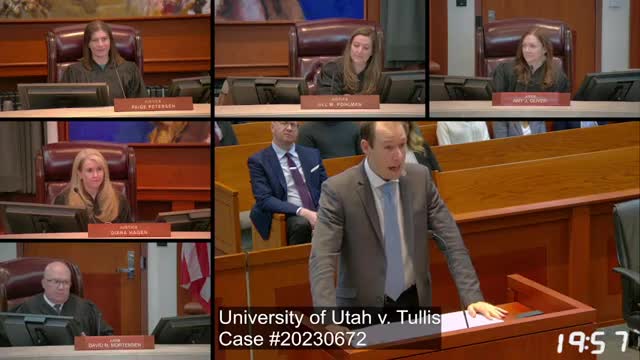Tullis case challenges hospital malpractice and $22M care costs in Utah Court
October 28, 2024 | Utah Supreme Court, Utah Judicial Branch, Utah
This article was created by AI summarizing key points discussed. AI makes mistakes, so for full details and context, please refer to the video of the full meeting. Please report any errors so we can fix them. Report an error »

The Utah Supreme Court convened on October 28, 2024, to hear oral arguments in the significant case of University of Utah v. Tullis, which centers on the devastating impact of alleged medical malpractice on the Tullis family. The case raises critical questions about liability and compensation for victims of negligence, particularly in the context of a child left permanently disabled due to hospital errors.
During the proceedings, the Tullis family's attorney emphasized the profound emotional and financial toll the malpractice has taken on their lives, highlighting the staggering $22 million needed for ongoing care. The attorney argued that the fundamental principle of American law mandates that victims of negligence should be compensated for their suffering. However, the hospital contends that the financial burden should fall on the victims rather than the tortfeasor.
A key point of contention in the arguments was the legal doctrine of stare decisis, which requires courts to adhere to established precedent. The Tullis attorney asserted that Utahns have relied on the precedent set by the Condemoran case for over 35 years, which supports the victims' right to compensation. The attorney argued that the hospital has not met the burden of proof necessary to overturn this precedent, as established by previous rulings.
The discussion also touched on the implications of changing legal standards, with justices questioning whether the current case aligns with past rulings, particularly in light of recent changes to relevant statutes. The attorney for the hospital suggested that longstanding practices should not automatically dictate current legal interpretations, prompting further debate among the justices.
As the court deliberates, the outcome of this case could have far-reaching implications for medical malpractice law in Utah, potentially affecting how victims are compensated and the responsibilities of healthcare providers. The Tullis family awaits a decision that will determine not only their financial future but also the broader legal landscape regarding medical negligence in the state.
During the proceedings, the Tullis family's attorney emphasized the profound emotional and financial toll the malpractice has taken on their lives, highlighting the staggering $22 million needed for ongoing care. The attorney argued that the fundamental principle of American law mandates that victims of negligence should be compensated for their suffering. However, the hospital contends that the financial burden should fall on the victims rather than the tortfeasor.
A key point of contention in the arguments was the legal doctrine of stare decisis, which requires courts to adhere to established precedent. The Tullis attorney asserted that Utahns have relied on the precedent set by the Condemoran case for over 35 years, which supports the victims' right to compensation. The attorney argued that the hospital has not met the burden of proof necessary to overturn this precedent, as established by previous rulings.
The discussion also touched on the implications of changing legal standards, with justices questioning whether the current case aligns with past rulings, particularly in light of recent changes to relevant statutes. The attorney for the hospital suggested that longstanding practices should not automatically dictate current legal interpretations, prompting further debate among the justices.
As the court deliberates, the outcome of this case could have far-reaching implications for medical malpractice law in Utah, potentially affecting how victims are compensated and the responsibilities of healthcare providers. The Tullis family awaits a decision that will determine not only their financial future but also the broader legal landscape regarding medical negligence in the state.
View full meeting
This article is based on a recent meeting—watch the full video and explore the complete transcript for deeper insights into the discussion.
View full meeting

